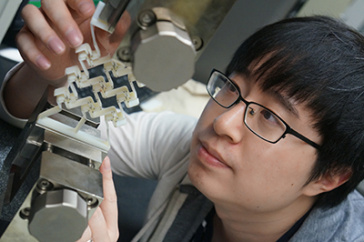The University of New Hampshire is a flagship research university that inspires innovation and transforms lives in our state, nation and world. More than 16,000 students from all 50 states and 71 countries engage with an award-winning faculty in top ranked programs in business, engineering, law, health and human services, liberal arts and the sciences across more than 200 programs of study. UNH’s research portfolio includes partnerships with NASA, NOAA, NSF and NIH, receiving more than $100 million in competitive external funding every year to further explore and define the frontiers of land, sea and space.
UNH Researchers Create New Concept That Could Lead to Improved Drug Delivery

Yunyao Jiang, a doctoral candidate in mechanical engineering at UNH, using 3D-printed prototype to prove concept of sequential cell-opening mechanism.
Credit: University of New Hampshire.
DURHAM, N.H. – Inspired by a color changing mechanism found in cephalopods, like squid, cuttlefish and octopus, researchers at the University of New Hampshire have conceived a design for a unique sequential cell-opening mechanism that has many potential applications from drug delivery to color altering camouflage materials.
The novel concept has broad probable uses in designing smart materials that can not only be responsive to external conditions like light, temperature, and humidity, but can also be developed into sensors, and materials for particle release, drug delivery and color changing camouflage. Specific examples include biomedical scaffolds, drug-release bandages, drug reservoirs and stents, innovative foldable or deployable devices, smart responsive composites and stretchable soft electronic materials. There is a pending patent which has been filed by UNHInnovation, which advocates for, manages, and promotes UNH’s intellectual property.
The research team created the concept by modifying the chiral geometry of two different cells that were designed to mimic the color-changing organs, or chromatophores, in the cephalopods. When loaded only in one direction, the two different cells (one large and one small) with different attributes, would open sequentially, one after the other. A multi-material 3D printer was instrumental in fabricating a fast prototype of the design and help prove the concept that used complicated geometry and materials. The study is a cover story for Advanced Engineering Materials.
“We used two different types of cells, one would open right away and the other would rotate first before opening in the sequence,” said Yaning Li, assistant professor of mechanical engineering at UNH and one of the authors. “What makes this unique is that if each cell is assigned a different color, you could alter the sequential opening mechanism to create a material that might be dark green when the first cell opened and then change to bright yellow when the second one opened after it. This concept could also be used for particle release, such as two different medicines being released sequentially through a bandage to help address medical issues like wound swelling.”
To prove the concept, the researchers created an innovative soft meta-material, discussed in an earlier study by the team. By customizing the chiral geometry at two different levels, the different size cells that were loaded only in one direction did open sequentially.
“The order of the cell opening can also be altered via geometry and material combination to alter the behavior of the cells and increase the number of potential applications”, said Yunyao Jiang, a doctoral candidate in mechanical engineering at UNH, and lead author.
This work was supported by a NSF/CAREER award to explore the mechanics of auxetic chiral metamaterials via innovative design and 3D printing.
For more information on licensing this patent-pending technology, contact unh.innovation@unh.edu.
Video and image to download:
Two different videos of the 3D-printed prototype demonstrate the chirality-induced sequential cell-opening mechanism and how the geometry and material can alter the behavior of the cells, which are represented by a small red particle and a larger blue particle.
Video 1:
https://www.dropbox.com/s/42zt85198n6ckc4/specimen%201.mp4?dl=0
Video 2:
https://www.dropbox.com/s/61md0joge564wle/specimen%203.mp4?dl=0
Photo 1:
https://www.unh.edu/unhtoday/sites/default/files/media/3-d_prototype.jpg
The 3D-printed prototype of the chirality-induced sequential cell-opening mechanism that has potential applications from drug delivery to color altering camouflage materials. Credit: University of New Hampshire.
Photo 2:
https://www.unh.edu/unhtoday/sites/default/files/media/yunyao_jiang.jpg
Yunyao Jiang, a doctoral candidate in mechanical engineering at UNH, using 3D-printed prototype to prove concept of sequential cell-opening mechanism.
Credit: University of New Hampshire.
Latest News
-
December 12, 2024
-
December 11, 2024
-
November 22, 2024
-
November 7, 2024
-
October 30, 2024
















































